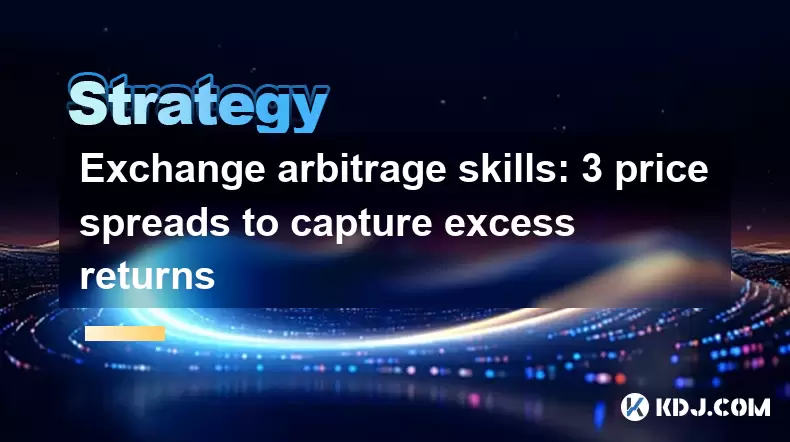-
 bitcoin
bitcoin $122025.899241 USD
-2.12% -
 ethereum
ethereum $4488.068729 USD
-4.11% -
 bnb
bnb $1315.348019 USD
8.65% -
 tether
tether $1.000457 USD
0.03% -
 xrp
xrp $2.875326 USD
-3.69% -
 solana
solana $222.043604 USD
-4.07% -
 usd-coin
usd-coin $0.999682 USD
0.00% -
 dogecoin
dogecoin $0.249887 USD
-5.62% -
 tron
tron $0.337379 USD
-2.59% -
 cardano
cardano $0.827763 USD
-5.06% -
 hyperliquid
hyperliquid $45.774531 USD
-2.43% -
 chainlink
chainlink $22.079309 USD
-5.87% -
 ethena-usde
ethena-usde $1.000156 USD
0.02% -
 sui
sui $3.482566 USD
-3.57% -
 stellar
stellar $0.386982 USD
-4.92%
交換套利技能:3個價格差為捕獲超額回報
Exchange arbitrage involves buying low on one crypto exchange and selling high on another, using spatial, cross-exchange, and triangular methods for profit.
2025/05/26 21:29

Exchange套利涉及利用不同加密貨幣交換的同一資產的價格差異。在揮發性的加密市場中,這種策略尤其是有利可圖的,因為價格差異很普遍。在本文中,我們將探討交易者可以用來通過Exchange套利來捕獲超額回報的三個特定價格差。
了解交換套利
Exchange套利是在價格較低的一個交易所購買加密貨幣的做法,同時在價格更高的另一個交易所出售。價格差異稱為價格差,是套利的利潤率。此方法需要快速執行,並且通常涉及自動交易系統以利用短暫的機會。
為了成功參與交換套利,交易者需要對加密市場,多次交流以及迅速執行交易的能力有深入的了解。讓我們潛入三個特定的價格價差,可以利用超額回報。
空間套利
空間套利涉及利用不同地理區域之間的價格差異。由於當地需求,監管環境和流動性水平等因素,加密貨幣價格可能會在各個地區之間有很大差異。
要進行空間套利,請執行以下步驟:
- 確定價格差異:使用CoinMarketCap或CryptoCompare等工具來監視全球不同交易所的價格。
- 選擇正確的交換:確保您在存在價格差異的交換方面擁有帳戶。考慮費用,提款限制和交易量之類的因素。
- 同時執行交易:以較低的價格購買交易所的加密貨幣,並以較高的價格在交易所出售。如果可能的話,請使用自動交易機器人來最大程度地減少執行時間。
- 轉移資金:在價格高價交易所出售後,將資金轉移回原始交易所或您的錢包,考慮到轉移費和時間。
空間套利可能是高度利潤的,尤其是在價格差異更明顯的流動性市場較少的地區。
跨交換套利
跨交換套利是加密空間中最常見的套利形式,涉及在不同交換中列出的相同資產。目的是從由於流動性和交易活動水平變化而導致的臨時價格差異中獲利。
要執行跨交換套利,請按照以下步驟:
- 監視多個交換:使用實時數據提要來跟踪不同平台上同一加密貨幣的價格。
- 計算潛在利潤:考慮所有相關費用,包括交易費用,提款費和轉移時間,以確保套利機會有利可圖。
- 快速執行交易:使用交易機器人或手動執行,同時在不同的交易所上同時購買和出售加密貨幣。
- 撤回和轉移資金:完成交易後,將資金從高價交易所撤回,然後將其轉移回原始交易所或您的錢包。
跨交換套利需要敏銳的眼睛,並能夠迅速採取行動以利用短暫的價格差異。
三角套利
三角套利涉及利用同一交易所上三種不同的加密貨幣之間的價格差異。此方法更複雜,但如果正確執行,則可以高度利潤。
要進行三角套利,請執行以下步驟:
- 確定一個三角機會:尋找三個加密貨幣(a,b和c),其中匯率之間創造了有利可圖的循環。例如,如果匯率從A到B,B到C和C回到A盈利的結果,則您找到了三角套利機會。
- 計算利潤率:使用當前的匯率來確定三角貿易在考慮費用後是否會導致淨利潤。
- 按順序執行交易:使用您的基本貨幣購買加密貨幣A,然後將a為b,b的b,最後,c回到您的基本貨幣。確保快速執行所有交易以捕獲套利機會。
- 監視和調整:不斷監視匯率,並準備在市場狀況發生變化時調整策略。
三角套利的執行可能更具挑戰性,但為大量回報提供了潛力,尤其是在波動性高的市場中。
套利的工具和技術
成功的套利交易通常依賴於高級工具和技術的使用。這裡有一些基本工具可以幫助您獲取超額回報:
- 套利機器人:自動交易機器人可以監視多個交易所,並執行交易的速度要比人類所能快得多。例子包括Gimmer和Blackbird。
- 實時數據提要:像CryptoCompare和Coinapi這樣的服務提供實時價格數據,這對於快速識別套利機會至關重要。
- API集成:許多交易所都提供API,使您可以將交易機器人和監視工具與其平台直接集成,從而無縫執行交易。
- 風險管理軟件:像Cryptotrader這樣的工具可以幫助您管理風險敞口,並確保您的套利策略保持盈利。
使用這些工具可以顯著增強您在加密市場中識別和利用套利機會的能力。
風險和考慮因素
雖然交易套利可能是高度盈利的,但它還帶來了交易者必須意識到的某些風險和考慮因素:
- 市場波動:加密貨幣市場高度波動,價格價差可能會迅速變化,有可能將有利可圖的機會變成損失。
- 交易費用:高交易和提款費用可能會侵蝕您的利潤率,因此必須將其分解為您的計算。
- 執行風險:進行跨不同交流的交易所需的時間會影響您捕獲全價差的能力。
- 監管風險:圍繞加密貨幣交易的不同司法管轄區有不同的法規,這可能會影響您參與套利的能力。
了解這些風險並採取措施減輕它們對於成功的套利交易至關重要。
常見問題
問:我可以手動執行交換套利,還是需要自動化工具?答:雖然可以手動執行交換套利,但使用自動化工具可以大大增加成功的機會。手動交易需要持續的監控和快速執行,這可能具有挑戰性,尤其是在動蕩的市場中。諸如套利機器人之類的自動工具可以監視多個交易所,並執行更快的交易,從而幫助您捕獲更多的機會。
問:如何從套利機會中計算潛在利潤?答:要計算套利機會的潛在利潤,您需要考慮交易所之間的價格上漲,以及所有相關費用,包括交易費,提款費和轉讓費。計算利潤的公式為:利潤=(賣出價格 - 買價 - 總費用)。確保售價高於買入價格以及所有費用,以確保盈利交易。
問:交換套利有任何法律限制嗎?答:交換套利的法律限制可能因管轄權而異。一些國家對加密貨幣交易有嚴格的規定,並可能對套利活動施加限制。在進行套利交易之前,必須研究和了解您所在地區的法律環境。始終遵守當地法律法規,以避免潛在的法律問題。
問:如何最大程度地降低與Exchange套利相關的風險?答:為了最大程度地降低與交換套利相關的風險,請考慮以下策略:使用自動工具快速執行交易,使您的套利機會多樣化,跨多個資產和交流,密切關注市場波動,以及所有相關成本的因素,以確保有利可圖的交易。此外,請了解可能影響您的交易活動的監管變更。
免責聲明:info@kdj.com
所提供的資訊並非交易建議。 kDJ.com對任何基於本文提供的資訊進行的投資不承擔任何責任。加密貨幣波動性較大,建議您充分研究後謹慎投資!
如果您認為本網站使用的內容侵犯了您的版權,請立即聯絡我們(info@kdj.com),我們將及時刪除。
- Blockdag,Doge,Hype贊助:加密趨勢塑造2025
- 2025-10-01 00:25:13
- 德意志·伯斯(DeutscheBörseand Circle):歐洲的穩定收養力量
- 2025-10-01 00:25:13
- Blockdag的預售嗡嗡聲:是2025年10月觀看的加密貨幣嗎?
- 2025-10-01 00:30:13
- 比特幣,加密和智商:當天才遇到數字黃金時?
- 2025-10-01 00:30:13
- Stablecoins,美國創新和錢包代幣:下一個邊界
- 2025-10-01 00:35:12
- 烏克蘭的NBU,硬幣和加密貨幣:紐約人
- 2025-10-01 00:45:14
相關知識

Bitcoin多時間幀移動平均係統的實用參數設置
2025-09-18 22:54:30
優化Bitcoin交易的時間範圍組合1。選擇適當的時間範圍對於Bitcoin構建多時間框架的平均係統至關重要。交易者通常將4小時,每日和每週圖表結合在一起,以捕獲不同的市場階段。 4小時的圖表有助於確定短期動量,而每日圖表確認了中期趨勢。每週圖表是確保交易與更廣泛的市場方向保持一致的過濾器。 2。一...

如何在Doge硬幣高頻交易中過濾掉錯誤的突破?
2025-09-22 01:00:37
了解Doge硬幣交易中的虛假突破1。當Doge硬幣的價格似乎超出了定義的支持或阻力水平,但很快逆轉,捕獲對初始信號行事的交易者,就會發生錯誤的突破。由於市場迅速波動和算法噪聲,這些誤導性運動在高頻交易中很常見。 2。在模因硬幣(例如Doge硬幣)的揮發性環境中,錯誤的突破發生頻率更高,因為情感驅動的...

用於識別Bitcoin鏈NVT模型中頂部和底部的技術
2025-09-20 19:54:27
了解Bitcoin分析中的NVT模型1。交易(NVT)比率的網絡價值通常被描述為加密貨幣市場的“ P/E比率”,與傳統的金融估值指標相似。它將Bitcoin的網絡價值(市值(市值)除以其區塊鏈的每日交易量。高NVT表明,相對於交易活動,網絡值升高,潛在的信號傳導高估。相反,低NVT可能表明低估了,尤...

對Bitcoin硬幣期貨的開放興趣的激增意味著什麼?
2025-09-20 23:18:28
了解Doge硬幣期貨的激增開放興趣1。 Doge硬幣期貨中的開放興趣激增表明,尚未解決的積極合同越來越多。該指標反映了零售和機構的交易者參與的增加,信號促進了市場參與度的提高。當開放興趣隨著價格上漲而上升時,它通常會證實新資本進入市場的支持的看漲趨勢。 2。提高的開放興趣還可以表明Doge硬幣衍生品...

如何使用以太坊USDT溢價來衡量市場情緒?
2025-09-18 23:55:12
了解以太坊USDT Premium 1。以太坊的溢價是指在基於以太坊的平台上交易的USDT(Tether)之間的價格差,尤其是在特定的區域市場上。這種偏差通常反映了需求不平衡和資本流限制。 2。當USDT在以太坊上交易1美元以上時,它表示保費。這通常發生在進入傳統銀行渠道有限的市場中,從而使貿易...

如果以太坊的積分產量下降,該怎麼辦?
2025-09-20 06:18:30
了解以太坊積分產量下降的原因1。以太坊網絡轉變為合併的證明共識機制,從根本上改變了驗證者的獎勵方式。隨著越來越多的參與者加入Staking生態系統,ETH鎖定的總量增加了,從而導致單個回報的天然稀釋。這是通過設計 - 協議根據固定供應的規模來調整獎勵,以維持經濟平衡。 2。網絡活動也起著至關重要的作...

Bitcoin多時間幀移動平均係統的實用參數設置
2025-09-18 22:54:30
優化Bitcoin交易的時間範圍組合1。選擇適當的時間範圍對於Bitcoin構建多時間框架的平均係統至關重要。交易者通常將4小時,每日和每週圖表結合在一起,以捕獲不同的市場階段。 4小時的圖表有助於確定短期動量,而每日圖表確認了中期趨勢。每週圖表是確保交易與更廣泛的市場方向保持一致的過濾器。 2。一...

如何在Doge硬幣高頻交易中過濾掉錯誤的突破?
2025-09-22 01:00:37
了解Doge硬幣交易中的虛假突破1。當Doge硬幣的價格似乎超出了定義的支持或阻力水平,但很快逆轉,捕獲對初始信號行事的交易者,就會發生錯誤的突破。由於市場迅速波動和算法噪聲,這些誤導性運動在高頻交易中很常見。 2。在模因硬幣(例如Doge硬幣)的揮發性環境中,錯誤的突破發生頻率更高,因為情感驅動的...

用於識別Bitcoin鏈NVT模型中頂部和底部的技術
2025-09-20 19:54:27
了解Bitcoin分析中的NVT模型1。交易(NVT)比率的網絡價值通常被描述為加密貨幣市場的“ P/E比率”,與傳統的金融估值指標相似。它將Bitcoin的網絡價值(市值(市值)除以其區塊鏈的每日交易量。高NVT表明,相對於交易活動,網絡值升高,潛在的信號傳導高估。相反,低NVT可能表明低估了,尤...

對Bitcoin硬幣期貨的開放興趣的激增意味著什麼?
2025-09-20 23:18:28
了解Doge硬幣期貨的激增開放興趣1。 Doge硬幣期貨中的開放興趣激增表明,尚未解決的積極合同越來越多。該指標反映了零售和機構的交易者參與的增加,信號促進了市場參與度的提高。當開放興趣隨著價格上漲而上升時,它通常會證實新資本進入市場的支持的看漲趨勢。 2。提高的開放興趣還可以表明Doge硬幣衍生品...

如何使用以太坊USDT溢價來衡量市場情緒?
2025-09-18 23:55:12
了解以太坊USDT Premium 1。以太坊的溢價是指在基於以太坊的平台上交易的USDT(Tether)之間的價格差,尤其是在特定的區域市場上。這種偏差通常反映了需求不平衡和資本流限制。 2。當USDT在以太坊上交易1美元以上時,它表示保費。這通常發生在進入傳統銀行渠道有限的市場中,從而使貿易...

如果以太坊的積分產量下降,該怎麼辦?
2025-09-20 06:18:30
了解以太坊積分產量下降的原因1。以太坊網絡轉變為合併的證明共識機制,從根本上改變了驗證者的獎勵方式。隨著越來越多的參與者加入Staking生態系統,ETH鎖定的總量增加了,從而導致單個回報的天然稀釋。這是通過設計 - 協議根據固定供應的規模來調整獎勵,以維持經濟平衡。 2。網絡活動也起著至關重要的作...
看所有文章










































































